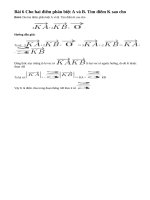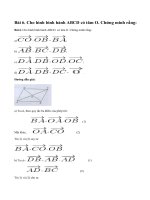Unit 6 trang 66 sgk Tiếng anh 9 |Giải SGK Tiếng anh lớp 9
Bạn đang xem bản rút gọn của tài liệu. Xem và tải ngay bản đầy đủ của tài liệu tại đây (239.07 KB, 4 trang )
<span class='text_page_counter'>(1)</span><div class='page_container' data-page=1>
<b>GIẢI SKILLS 1 UNIT 6 SGK TIẾNG ANH 9</b>
<i><b>1. Work in pairs to answer the following questions. (Làm việc theo cặp rồi trả lời câu </b></i>
<i>hỏi sau.)</i>
<b>1. The first picture shows an old tram. The second picture shows a modern train.</b>
<b>2. The tram would have been seen in a town or city. These trains can be seen nowadays in</b>
big, modern cities.
<b>3.</b>
<b>Old tram</b> <b>Modern train</b>
Compartment Two or three Four
Speed Low High
Air-conditioner No Yes
Runs on The ground at street level Elevated tracks
Powered by Overhead electricity wires Electromagnetics
</div>
<span class='text_page_counter'>(2)</span><div class='page_container' data-page=2>
1. In which century was the tram system built?
2. What was the role of the tram system in Ha NoT
3. When was the system removed?
4. What has happened to Ha Noi's population over the last two decades?
5. How has the tram system in Ha Noi been improved recently?
6. Which of the transport systems do you think : more impressive to Hanoians?
<i><b>Hướng dẫn giải</b></i>
<b>1. In the 20th century.</b>
<b>2. It was a major means of transport for Hanoians.</b>
<b>3. In 1990.</b>
<b>4. The population has increased dramatically.</b>
<b>5. New rail systems including a skytrain and a subway are under way.</b>
<b>6. The first tramways in 1900. Đường xe điện đầu tiên vào năm 1900.</b>
</div>
<span class='text_page_counter'>(3)</span><div class='page_container' data-page=3>
<i><b>Hướng dẫn giải</b></i>
1. F 2. T 3. F 4. T 5. F
<i><b>Hướng dẫn dịch</b></i>
<b>1. Mục đích của đoạn văn là thuyết phục mọi người đi xe điện trên cao.</b>
<b>2. Người Hà Nội gắn bó sâu sắc với hệ thơng tàu điện của họ.</b>
<b>3. Hệ thống xe điện của Hà Nội chỉ hoạt động ở khu vực thành thị.</b>
<b>4. Có sự tăng nhanh số lượng phương tiện ở Hà Nội.</b>
<b>5. Hệ thông tàu điện trên cao mới đã chạy được 2 năm.</b>
<i><b>4. Work in pairs. List different types of traditional .... (Làm việc theo cặp. Liệt kê các </b></i>
<i>loại phương tiện giao thông truyền thống và hiện đại ở Việt Nam.)</i>
<i><b>Hướng dẫn giải</b></i>
<b>Past</b> <b>Present</b>
Road
types
path, earthen road, trench, brick
road, tunnel, alley, tram system
underpass, flyover, skytrain system, sky
walk system, cable car, tunnel, alley
</div>
<span class='text_page_counter'>(4)</span><div class='page_container' data-page=4>
<i><b>5. Discuss the changes in transport in your neighbourhood. Is there ... (Thảo luận </b></i>
<i>những thay đổi trong giao thông ở vùng xung quanh bạn. Có điều gì bạn thích hơn ở </i>
<i>giao thơng truyền thống hoặc hiện đại nơi bạn sống không?)</i>
<i><b> Hướng dẫn giải</b></i>
I prefer the modern train than the old tram in my city because it’s much faster and it has
air conditioner so that my trip is more comfortable.
Now in city, there are more buses than in the past. I like that because they help to reduce
pollution and the fees are quite cheap.
<i><b>Hướng dẫn dịch</b></i>
- Tơi thích sử dụng lối đi dành cho người đi bộ hơn là vỉa hè trên những con đường đông
đúc ở thành phố của tơi bởi vì nó an tồn hơn nhiều cho bộ hành và ở đó ít ơ nhiễm hơn.
</div>
<!--links-->









